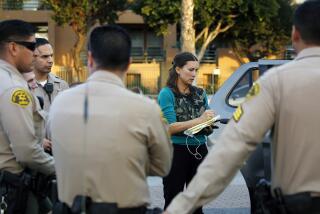‘Die Hard 2’--It’s Hard to Find Any Resemblance to a Real TV Reporter
- Share via
I would rather spend a few hours waving my American passport around at a political rally in Tehran or dodging shrapnel on a hot summer night in Beirut than suffer again through a movie like “Die Hard 2.”
It’s painful to watch those Hollywood fantasies in which bullets are exchanged at greater rates than during the entire invasion of Panama, where terrorists have the intellectual depth of Silicon Valley entrepreneurs and where the TV reporter is depicted as a pompous, irresponsible louse.
I’ve never seen any of that in 25 years of covering revolutions, coups, terrorist attacks and urban crime, most of that time as a correspondent for NBC News.
We have come to expect $60-million epics to produce huge body counts and to create bad guys with the cunning of a Dr. No. That kind of mayhem is at least plausible. Palestinian terrorist Abu Nidal has written such real-world scenarios in the blood of hundreds of victims in Europe and the Middle East. But I’ve never met a reporter like Richard Thornberg, the TV heavy in the “Die Hard” films.
In both movies, the Thornberg character is an egomaniacal local reporter itching to ride to the big time, a network news operation, on a major scoop. In the first movie he ferrets out the home of hostage Holly McClane and puts her kids on live television, thus exposing the mother.
In his current incarnation, Thornberg does a live telephone broadcast from an airliner that is circling over an airport under siege by terrorists. His villainous reporting--”The likelihood of a full-scale battle (at the airport) is dangerously close”--sends a holiday-crowded terminal screaming in panic.
The Thornberg character defends his actions as honest news gathering in pursuit of the people’s right to know. That’s as trite and as out of touch with reality as a studio screenwriter can make it. The people do have a right to know, but not when it puts lives in danger.
No major television news operation in this country would give a reporter that kind of live access to an audience.
Do reporters say and do stupid things on live television? Sure, every night. Do reporters make mistakes on the air? Absolutely. I’ve had a few dillies in my years. Yet I’ve never seen or heard a television news report that endangered lives.
In 1986, from my post as Pentagon correspondent for NBC News, I learned that the United States was about to launch an air raid on Moammar Kadafi’s Libya. It was the major story of that year. NBC News did not broadcast that information. There was never any question of going on the air. It was a prize-winning scoop that would have cost the lives of American airmen.
Other reporters I know have had similar exclusives. None used it. That’s the real world.
The first “Die Hard” director, John McTiernan, who made Bruce Willis’ John McClane a box-office favorite, at least had a plausible plot to mold into a megahit of unspeakable violence and one-liners. But McTiernan’s brilliance in mixing the art of the possible with a James Bond character from New York was flared by the TV reporter’s intrusion into the home of a hostage.
Last year, on the set of “The Hunt for Red October,” a film as real as the Pentagon’s budget, McTiernan offered a feeble defense of his reporter. He said, as I recall, “Yes, I know those things don’t actually happen, but a director is permitted great license.”
After spending time with McTiernan during the production of “Red October,” I believe he has a great talent for making movies that are both adventurous and realistic. McTiernan even cast real sailors so that the dialogue would ring true.
But “Red October,” although a box-office success, won’t match the revenue that all the muzzle flashes and bad characterizations will bring to “Die Hard 2.”
Killing bad guys in new and ingenious ways is big business. Hollywood has finally found a protagonist who can take more punishment and punch more holes in his adversaries than Rambo and Agent 007 combined.
But there is hope for an equally lovable, and authentic, reporter to be cast in the inevitable sequel. “Die Hard 2” director Renny Harlin used the old convention of the TV newscast to carry the early plot. Harlan had fictional WZDC reporter Samantha Copeland do live on-scene broadcasts to set up the airport arrival of captured drug kingpin/Latin American dictator Gen. Ramon Esperanza. In a news flash, Copeland reports: “The American war on drugs has finally taken its first prisoner.” Not a bad turn of phrase. I’ve heard worse on NBC News.
Copeland’s reportorial skills throughout “Die Hard 2” were the stuff of real journalism. She was pushy and smart. If she was off the mark at all it was in the casting. Copeland was a blonde--the right hair color for today’s female TV reporter . . . but she was no Barbie doll. I found that refreshing.
So, bring on “Die Hard 3.” But if the next director must cast the reporter Thornberg, have him die at the hands of a fanatical gunman early on. That would be real enough, as long as Samantha Copeland reports it.
See letters to Counterpunch, F7.
More to Read
Only good movies
Get the Indie Focus newsletter, Mark Olsen's weekly guide to the world of cinema.
You may occasionally receive promotional content from the Los Angeles Times.










